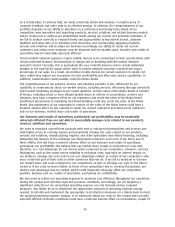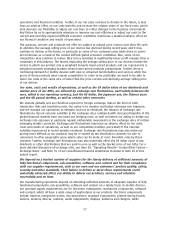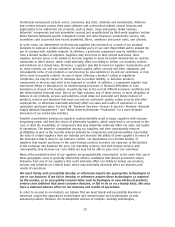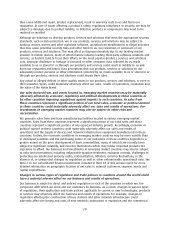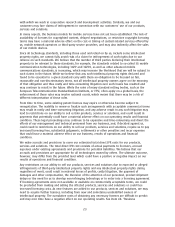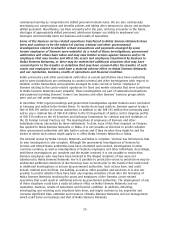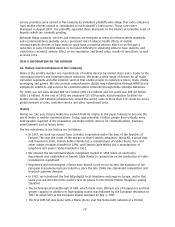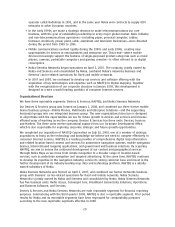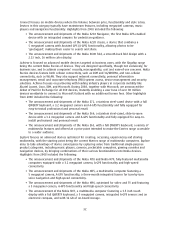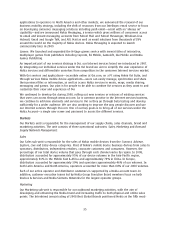Nokia 2008 Annual Report Download - page 26
Download and view the complete annual report
Please find page 26 of the 2008 Nokia annual report below. You can navigate through the pages in the report by either clicking on the pages listed below, or by using the keyword search tool below to find specific information within the annual report.systems and networks in our operations may impair our operational efficiency or competitiveness
which could have a material adverse effect to our business and results of operations.
The networks infrastructure business relies on a limited number of customers and large
multiyear contracts. Unfavorable developments under such a contract or in relation to a
major customer may adversely and materially affect our sales, results of operations and
financial condition.
Large multiyear contracts, which are typical in the networks industry, include a risk that the timing
of sales and results of operations associated with those contracts will differ from what was expected
when the contracts were entered into. Moreover, such contracts usually require the dedication of
substantial amounts of working capital and other resources, which affects our cash flow negatively, or
may require Nokia Siemens Networks to sell products, services and solutions in the future that would
otherwise be discontinued, thereby diverting resources from developing more profitable or
strategically important products. Any nonperformance by Nokia Siemens Networks under these
contracts may have significant adverse consequences for us because network operators have
demanded and may continue to demand stringent contract undertakings, such as penalties for
contract violations.
Providing customer financing or extending payment terms to customers can be a competitive
requirement and could have a material adverse effect on our results of operations and
financial condition.
Customers in some markets sometimes require their suppliers, including us, to arrange or provide
financing in order to obtain sales or business. Moreover, they may require extended payment terms.
In some cases, the amounts and duration of these financings and trade credits, and the associated
impact on our working capital, may be significant. In response to the recent tightening of the credit
markets, requests for customer financing are beginning to increase in volume and scope. We do not,
however, currently intend to significantly increase financing to our customers, which may have an
adverse effect on our ability to compete successfully for their business. Rather, as a strategic market
requirement, we plan to continue to arrange and facilitate financing to our customers and provide
financing and extended payment terms to a small number of selected customers. Extended payment
terms may continue to result in a material aggregate amount of trade credits, but the associated risk
is mitigated by the fact that the portfolio relates to a variety of customers. We cannot guarantee that
we will be successful in arranging, facilitating and providing needed financing to customers
particularly in the current difficult financial markets. Also, our ability to manage our total customer
finance and trade credit exposure depends on a number of factors, including our capital structure,
market conditions affecting our customers, the level and terms of credit available to us and our ability
to mitigate exposure on acceptable terms. We may not be successful in managing the challenges
connected with the total customer financing and trade credit exposure that we may have from time
to time. Defaults under financings and trade credits to our customers resulting in impairment charges
and credit losses have increased recently, and may continue to increase in the future, due to the
current difficult global economic conditions. See Item 5B. “Liquidity and Capital Resources—
Structured Finance,” and Note 35(b) to our consolidated financial statements included in Item 18 of
this annual report for a more detailed discussion of issues relating to customer financing, trade
credits and related commercial credit risk.
If we are unable to retain, motivate, develop and recruit appropriately skilled employees, our
ability to implement our strategies may be hampered and, consequently, that may have a
material adverse effect on our business and results of operations.
We must continue to retain, motivate, develop through constant competence training, and recruit
appropriately skilled employees with a comprehensive understanding of our current businesses and
technologies and the new market segments that we target. While we are to a certain extent reducing
our personnel through various targeted measures due to the current difficult global economic
conditions, we seek to create a corporate culture that is motivating, encourages creativity and
25



